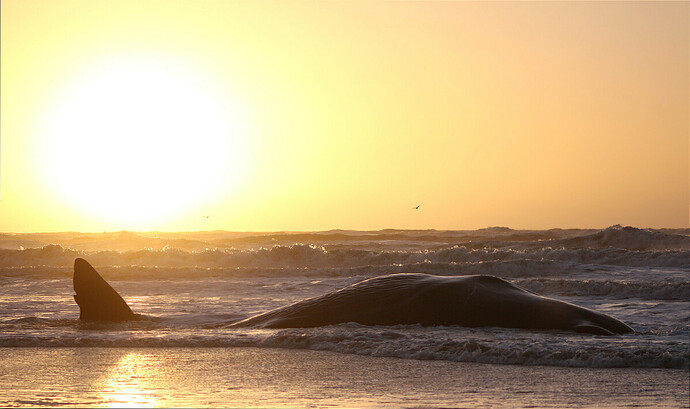I’ve seen my fair share of tall trees in my life, but I’ve also been able to look through a microscope every so often to see the various microorganism species also found in my area. I’m interested - what are your champions for the biggest and smallest organisms you’ve observed?
Biggest wise, its definitely a tree, and I have no good way of figuring out which one is actually the biggest but if its not one of the tulip trees I’ve observed, its certainly this absolute unit of a red maple https://www.inaturalist.org/observations/188268110
Smallest? maybe this tardigrade? https://www.inaturalist.org/observations/200677746
https://uk.inaturalist.org/observations/174843511 An epic beech with I think 7 trunks.
https://uk.inaturalist.org/observations/214762082 This orange springtail with little smiley-face dot eyes. : >
Trees are my largest and I cannot tell which one is largest !
I’m sure Plump Springtails are the smallest I have photographed. This guy was unexpectedly cute!
Largest: giant sequoia (Sequoiadendron giganteum) from Big Trees Trail, Sequoia National Park. For scale: there are four people in this picture
Smallest: Genus Oscillatoria from American Canyon, CA. For scale: the black lozenge represents a particle size of 100 micrometers; the open circle, 200 micrometers.
I don’t know if it counts as it isn’t technically an organism and I haven’t actually seen it: I observed a plant virus infecting Oxalis acetosella
That would be the smallest “thing” in my iNaturalist life list.
If that doesn’t count, I have some observations of bacteria that I haven’t identified any further.
The biggest would be some kind of tree, I have no idea which, though.
I think it’s safe for me to say a Rotifer was the smallest, and a Sperm Whale the largest!
Smallest organism observed? Not directly, but viral infections. Plant vilus gall say. Oh, my own Covid test results too! And there are even smaller infectors than viruses. But most definitions of organisms exclude viruses, so I guess it would be evidence of a bacterial infection.
Biggest? That’s hard.
By mass, do you mean living tissue? How much of a tree is actually living? The wood is structural but no longer metabolizing.
Or how about coral or giant clams? Is an animal with a full stomach, or mouthful of water (say a filter feeding whale) ‘bigger’ than one without? Do the aspen clonal colonies or giant honey mushroom networks count as an ‘organism’?
“Big” is such a variable term, I want to leave it up to you. If that translates to living tissue, total volume, or even just how big something appears to the human eye, it’s fitting for this post. Heck, show us all three if you’d like!
Yesterday, I found Scapholeberis and Daphnia, two genera of water fleas. I’ve also now noticed a copepod there. These would be the smallest creatures I’ve seen, excluding viruses and bacteria
For animals…
… the largest is probably this sad sperm whale from Denmark
… the smallest adult probably something like this collembola which is about 1,5mm
For plants I guess I observed this Kapok tree from Ecuador as my largest
…and smallest this Duckweed as a by-catch I guess
Largest: probably this Eastern White Pine:
https://www.inaturalist.org/observations/88768189
Smallest: This tardigrade:
https://www.inaturalist.org/observations/35091368
Smallest is an elongated springtail:
https://www.inaturalist.org/observations/176734629
Maybe not that one specifically, as a have a few. I went with the one with the best photo.
Largest (by far) is a Southern Wright Whale:
https://www.inaturalist.org/observations/144504258
My largest is probably this American Sycamore with a trunk circumference probably around ten feet.
My smallest without going microscopic is this insect from the Galapagos, which was probably only a millimeter long.
I am having trouble figuring out which one, but the largest organism I have ever seen is probably a tree. Here are links to a few that I think are contenders. (https://www.inaturalist.org/observations/73199331) , (https://www.inaturalist.org/observations/173242471),
(https://www.inaturalist.org/observations/88413966)
For my smallest non - microscopic organism, I’d probably have to go with Globular springtail. I was surprised and fortunate I was able to get my camera to focus on this little critter long enough to snap a photo.
Biggest is hard to guess. It’ll be some sort of suckering tree where it’s ‘technically’ one - so, maybe this at-least-11-hefty-trunks-and-more-suckers European Aspen. It’s a poplar, so the roots probably go far too. For single trees, what is supposedly Britain’s tallest London Plane is probably the one (and London Planes get big!).
Smallest are either plant-infecting bacteria, or if that’s cheating, gall mites (okay, the galls are way larger than the mites, but you don’t need a microscope to ‘see’ them, it counts!)
If you use a microscope, you can see little blobs wiggling around the galls https://www.inaturalist.org/photos/236771972
Too bad the height is so difficult to capture in a photo frame. It must have been really something to be there.
This topic was automatically closed 60 days after the last reply. New replies are no longer allowed.






